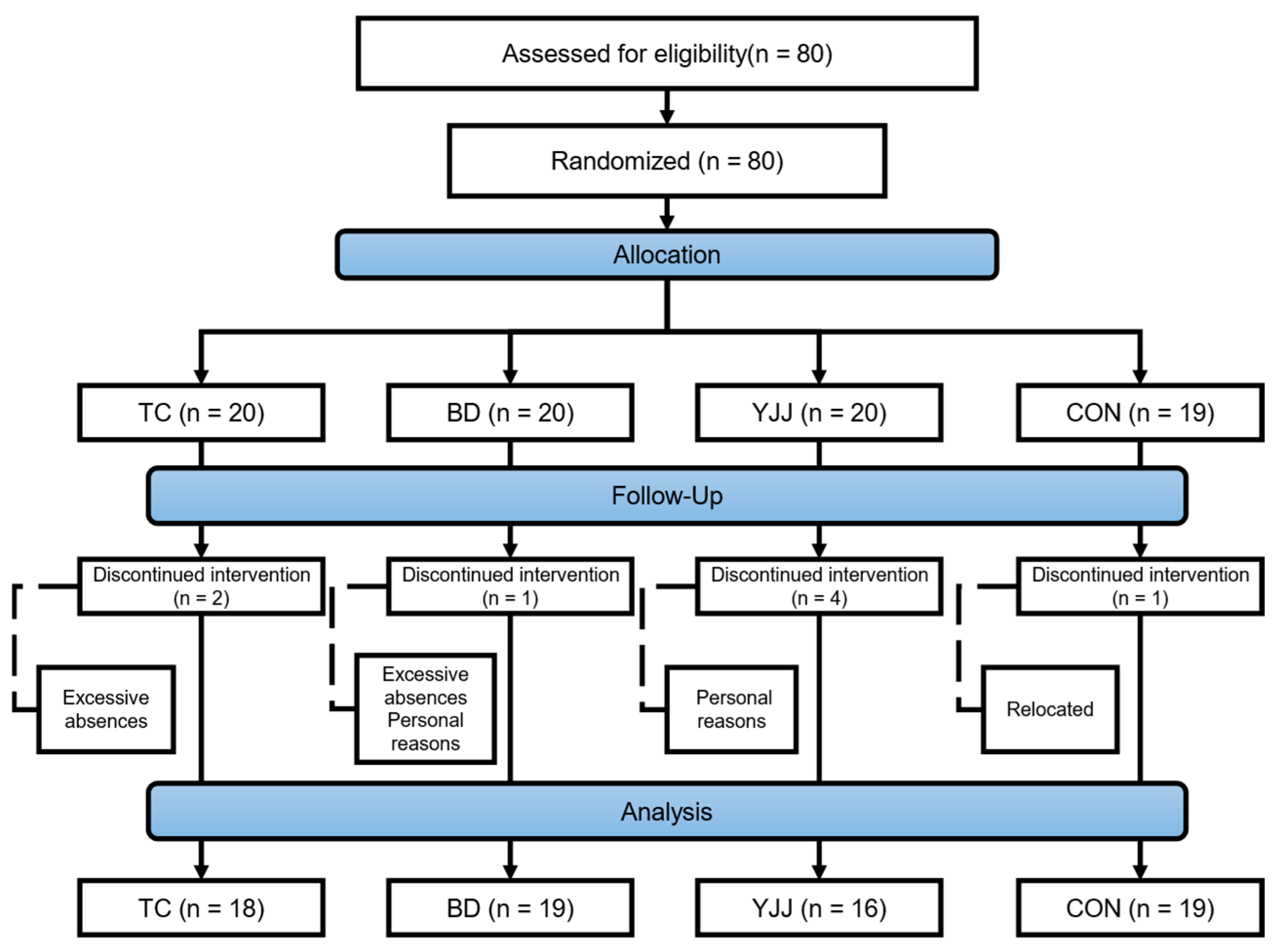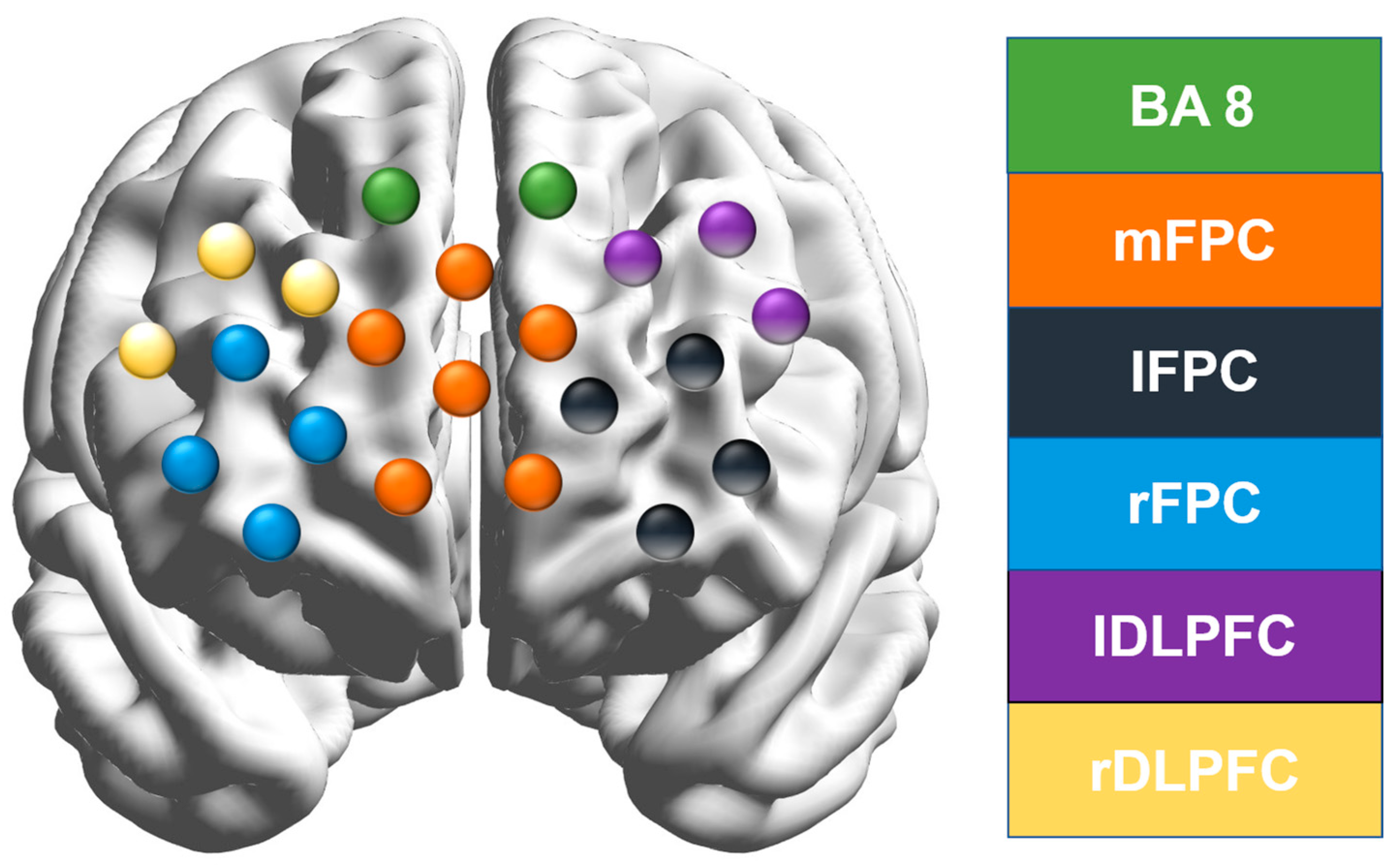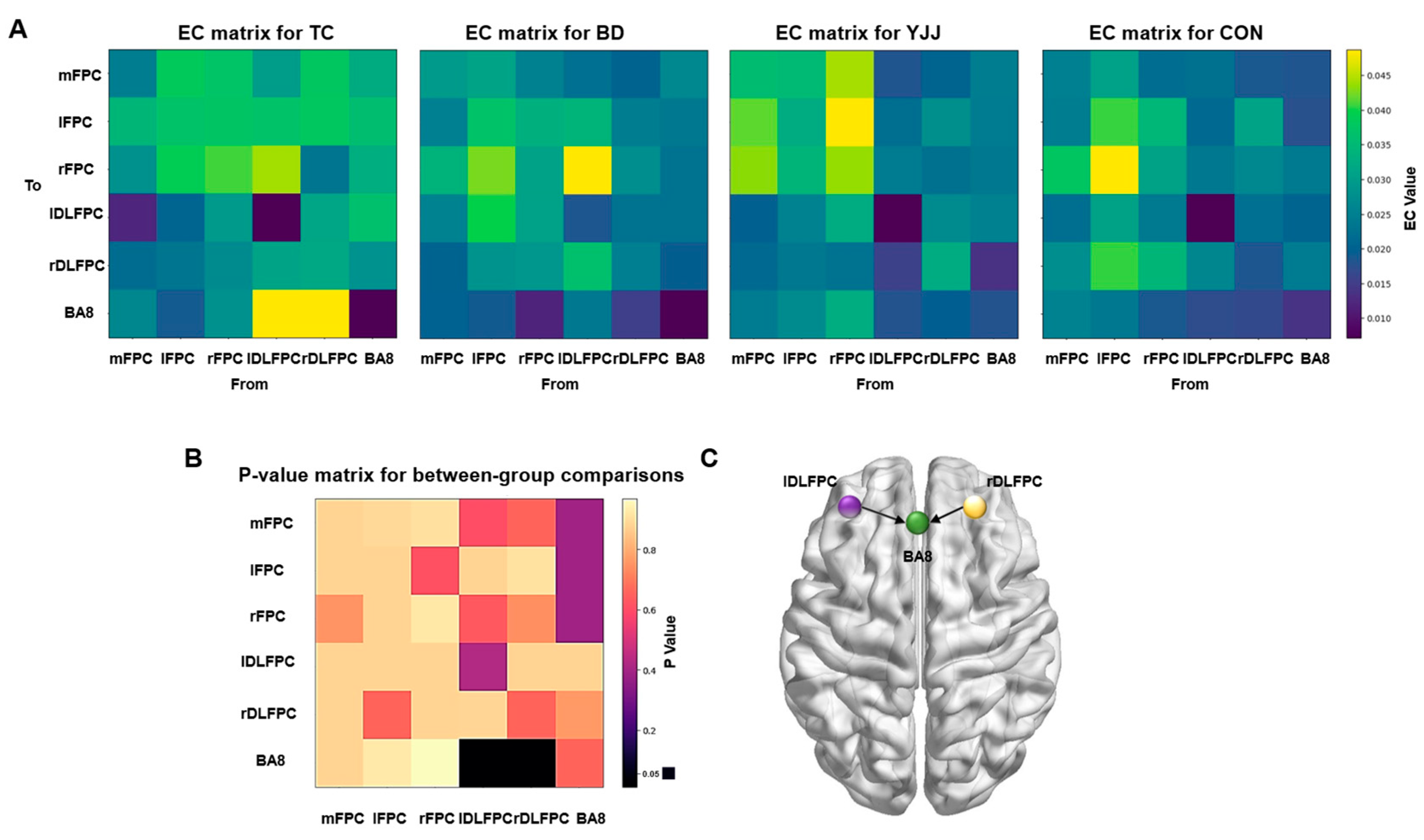Effects of Different Traditional Chinese Mind–Body Exercises on Learning Abilities, Executive Functions, and Brain Connectivity in Children with Learning Difficulties
Abstract
1. Introduction
2. Research Methods
2.1. Participants
2.2. Study Design
- Tai Chi group (TC).
- Baduanjin group (BD).
- Health Qigong Yijinjing group (YJJ).
2.3. Intervention Protocols
- Tai Chi: The Tai Chi intervention used a simplified form of Yang-style Tai Chi adapted from a six-movement sequence endorsed by the National Sports Administration. This sequence included Opening Posture, Wave Hands Like Clouds, Double Whip, White Crane Spreads Its Wings, Cross Hands, and Closing Posture. Training began with demonstrations and detailed instruction by certified trainers. Participants were required to mimic the movements under supervision, focusing on posture and breathing techniques. Those who did not meet performance criteria were provided additional instruction and reassessment.
- Baduanjin: The Baduanjin intervention followed the 2003 standardized “Health Qigong Baduanjin” form developed by the National Sports Administration. This practice consists of eight continuous, coordinated movements characterized by slow, controlled motions. Certified instructors demonstrated and monitored all movements, ensuring consistency with the standardized form. The training regimen mirrored the Tai Chi protocol in terms of structure and supervision.
- Health Qigong Yijinjing: The Yijinjing intervention was based on the 2003 standardized “Health Qigong Yijinjing”. Six movements were selected to accommodate the study population: First Offering to Buddha, Second Offering to Buddha, Third Offering to Buddha, Spreading Wings, Nine Ghosts Drawing Swords, and Forward Bend. Training included demonstrations, movement correction, and safety monitoring, facilitated by a certified instructor and an assistant to ensure proper execution.
2.4. Measurement Tools
- Academic Performance Ranking (APR)Academic performance in Chinese and Mathematics was measured through class ranking percentiles. Rankings were provided by homeroom teachers and included average scores for these two subjects. To ensure privacy, all scores were anonymized using participant identification numbers, protecting individual information confidentiality.
- Pupil Rating Scale (PRS)The PRS, developed by H.R. Myklebust in 1981, includes verbal and non-verbal subscales and evaluates five behavioral domains: auditory comprehension and memory, language, temporal and spatial judgment, motor coordination, and social behavior. The scope of the scale is from 3 to 15 years of age. The scale is assessed by trained classroom teachers in each class. The Chinese version of this scale demonstrates excellent internal consistency (Cronbach’s α = 0.85)
- Behavior Rating Inventory of Executive Function (BRIEF)The parent-reported version of the BRIEF, developed by Gioia et al. (2000), was used to assess executive functioning. It includes two indices, the Behavioral Regulation Index (BRI) and Metacognition Index (MI), further subdivided into eight domains: inhibition, shifting, emotional control, initiation, working memory, planning, organization, and monitoring. The scale comprises 86 items, rated on a three-point Likert scale, with higher scores indicating greater executive function deficits. The Chinese version of this scale demonstrates excellent internal consistency (Cronbach’s α = 0.86)
2.5. Neuroimaging Data Acquisition
2.6. Brain Connectivity Analysis
2.7. Statistical Analysis
3. Results
3.1. Baseline Data
3.2. Post-Intervention Comparisons
3.3. Effective Connectivity
4. Discussion
4.1. Post-Intervention Effects on Learning Ability and Executive Functioning in Children with LDs
4.1.1. Pupil Rating Scale
4.1.2. Academic Performance Ranking (APR)
4.1.3. Inhibition
4.1.4. Working Memory
4.2. Post-Intervention Effects on Brain Function in Children with LDs
4.2.1. Effective Connectivity and Pupil Rating Scale
4.2.2. Effective Connectivity and Academic Performance Ranking (APR)
4.2.3. Effective Connectivity and Inhibition
4.2.4. Effective Connectivity and Working Memory
5. Conclusions
Author Contributions
Funding
Institutional Review Board Statement
Informed Consent Statement
Data Availability Statement
Conflicts of Interest
References
- Andoh, J. (2020). Disruption of the prefrontal cortex improves implicit contextual memory-guided attention: Combined behavioral and electrophysiological evidence. Cerebral Cortex, 30(1), 20–30. [Google Scholar] [CrossRef]
- Anzeneder, S., Zehnder, C., Martin-Niedecken, A. L., Schmidt, M., & Benzing, V. (2023). Acute exercise and children’s cognitive functioning: What is the optimal dose of cognitive challenge? Psychology of Sport and Exercise, 66, 102404. [Google Scholar] [CrossRef] [PubMed]
- Bidzan-Bluma, I., & Lipowska, M. (2018). Physical activity and cognitive functioning of children: A systematic review. International Journal of Environmental Research and Public Health, 15(4), 800. [Google Scholar] [CrossRef] [PubMed]
- Brocken, J. E. A., Kal, E. C., & van der Kamp, J. (2016). Focus of attention in children’s motor learning: Examining the role of age and working memory. Journal of Motor Behavior, 48(6), 527–534. [Google Scholar] [CrossRef]
- Chen, H., Wang, Y., Zhang, M., Wang, N., Ge, S., & Liu, Y. (2024). Effectiveness of Tai Chi on cognitive function among older adults with mild cognitive impairment: A systematic review and meta-analysis of randomized controlled trials. Aging & Mental Health, 28(2), 285–293. [Google Scholar] [CrossRef]
- Converse, A. K., Ahlers, E. O., Travers, B. G., & Davidson, R. J. (2014). Tai chi training reduces self-report of inattention in healthy young adults. Frontiers in Human Neuroscience, 8, 13. [Google Scholar] [CrossRef]
- D’Mello, A. M., & Gabrieli, J. D. E. (2018). Cognitive neuroscience of dyslexia. Language, Speech, and Hearing Services in Schools, 49(4), 798–809. [Google Scholar] [CrossRef]
- Diamond, A., & Lee, K. (2011). Interventions shown to aid executive function development in children 4 to 12 years old. Science, 333(6045), 959–964. [Google Scholar] [CrossRef]
- Feng, H., Hui, K., & Guo, K. (2024). Relationship between physical exercise and mental health of college students: Chain mediating role of fulfillment of basic psychological needs and peer relationships. Social Behavior and Personality, 52(10), 1–9. [Google Scholar] [CrossRef]
- Fingelkurts, A. A., Fingelkurts, A. A., & Kähkönen, S. (2005). Functional connectivity in the brain—Is it an elusive concept? Neuroscience and Biobehavioral Reviews, 28(8), 827–836. [Google Scholar] [CrossRef]
- Gillberg, C., & Soderstrom, H. (2003). Learning disability. Lancet, 362(9386), 811–821. [Google Scholar] [CrossRef] [PubMed]
- Gioia, G. A., Isquith, P. K., Guy, S. C., & Kenworthy, L. (2000). Behavior rating inventory of executive function. Child Neuropsychology, 6, 235–238. [Google Scholar] [CrossRef] [PubMed]
- Handler, S. M., Fierson, W. M., Section on Ophthalmology, Council on Children with Disabilities, American Academy of Ophthalmology, American Association for Pediatric Ophthalmology and Strabismus & American Association of Certified Orthoptists. (2011). Learning disabilities, dyslexia, and vision. Pediatrics, 127(3), e818–e856. [Google Scholar] [PubMed]
- Huston, P., & McFarlane, B. (2016). Health benefits of tai chi: What is the evidence? Canadian Family Physician Medecin de Famille Canadien, 62(11), 881–890. [Google Scholar]
- Kelly, D. P. (2005). Learning disorders. Pediatric Annals, 34(4), 259–262. [Google Scholar] [CrossRef]
- Kronenberger, W. G., & Dunn, D. W. (2003). Learning disorders. Neurologic Clinics, 21(4), 941–952. [Google Scholar] [CrossRef]
- Li, G., Huang, P., Cui, S., He, Y., Jiang, Q., Li, B., Li, Y., Xu, J., Wang, Z., Tan, Y., & Chen, S. (2024). Tai Chi improves non-motor symptoms of Parkinson’s disease: One-year randomized controlled study with the investigation of mechanisms. Parkinsonism & Related Disorders, 120, 105978. [Google Scholar] [CrossRef]
- Li, X., Geng, J., Du, X., Si, H., & Wang, Z. (2022). Relationship between the practice of tai chi for more than 6 months with mental health and brain in university students: An exploratory study. Frontiers in Human Neuroscience, 16. [Google Scholar] [CrossRef]
- Lin, M., Ma, C., Zhu, J., Gao, J., Huang, L., Huang, J., Liu, Z., Tao, J., & Chen, L. (2022). Effects of exercise interventions on executive function in old adults with mild cognitive impairment: A systematic review and meta-analysis of randomized controlled trials. Ageing Research Reviews, 82, 101776. [Google Scholar] [CrossRef]
- Liu, Y., Feng, Q., & Tong, Y. (2024). Physical exercise and college students’ mental health: Chain mediating effects of social-emotional competency and peer relationships. Social Behavior and Personality, 52(7), 1–11. [Google Scholar] [CrossRef]
- McDowell, M. (2018). Specific learning disability. Journal of Paediatrics and Child Health, 54(10), 1077–1083. [Google Scholar] [CrossRef] [PubMed]
- McNeill, J., Howard, S. J., Vella, S. A., Santos, R., & Cliff, D. P. (2018). Physical activity and modified organized sport among preschool children: Associations with cognitive and psychosocial health. Mental Health and Physical Activity, 15, 45–52. [Google Scholar] [CrossRef]
- Nejati, V., & Estaji, R. (2024). The impact of transcranial direct current stimulation on attention bias modification in children with ADHD. Journal of Neural Transmission, 131(7), 823–832. [Google Scholar] [CrossRef] [PubMed]
- Nejati, V., Estaji, R., & Helisaz, Z. (2023). Transcranial direct-current stimulation improves verbal fluency in children with attention deficit hyperactivity disorder (ADHD). Brain Sciences, 13(9), 1257. [Google Scholar] [CrossRef]
- O’Brien, G., & Pearson, J. (2004). Autism and learning disability. Autism: The International Journal of Research and Practice, 8(2), 125–140. [Google Scholar] [CrossRef]
- Orth, M., Wagnon, C., Neumann-Dunayevska, E., Kaller, C. P., Klöppel, S., Meier, B., Henke, K., & Peter, J. (2023). The left prefrontal cortex determines relevance at encoding and governs episodic memory formation. Cerebral Cortex, 33(3), 612–621. [Google Scholar] [CrossRef]
- Pan, J.-L., Yin, H.-C., Chen, A.-G., Cui, L., Wang, Y., & Cui, Y.-B. (2016). An experimental study on the effect of exercise intervention on the executive functions of primary students with and without learning difficulties. China Sport Science, 6, 84–91+97. [Google Scholar] [CrossRef]
- Sarabzadeh, M., Azari, B. B., & Helalizadeh, M. (2019). The effect of six weeks of Tai Chi Chuan training on the motor skills of children with Autism Spectrum Disorder. Journal of Bodywork and Movement Therapies, 23(2), 284–290. [Google Scholar] [CrossRef]
- Shaheen, S. (2014). How child’s play impacts executive function—Related behaviors. Applied Neuropsychology Child, 3(3), 182–187. [Google Scholar] [CrossRef]
- Shapiro, B. K., & Gallico, R. P. (1993). Learning disabilities. Pediatric Clinics of North America, 40(3), 491–505. [Google Scholar] [CrossRef]
- Shemtob, L., Ramanathan, R., & Courtenay, K. (2021). Learning disability registers: Known unknowns and unknown unknowns. The British Journal of General Practice: The Journal of the Royal College of General Practitioners, 71(705), 153–154. [Google Scholar] [CrossRef] [PubMed]
- Shen, Q.-Q., Yin, H.-C., Cui, L., Zhang, J.-Y., Wang, D.-L., Zhu, L.-N., Wang, Y., & Li, X.-J. (2021). The potential advantages of tai chi chuan in promoting inhibitory control and spontaneous neural activity in young adults. Frontiers in Behavioral Neuroscience, 15, 747733. [Google Scholar] [CrossRef] [PubMed]
- Silver, L. B. (1971). The neurologic learning disability syndrome. American Family Physician, 4(1), 95–102. [Google Scholar]
- Simos, P. G., Rezaie, R., Fletcher, J. M., Juranek, J., Passaro, A. D., Li, Z., Cirino, P. T., & Papanicolaou, A. C. (2011). Functional disruption of the brain mechanism for reading: Effects of comorbidity and task difficulty among children with developmental learning problems. Neuropsychology, 25(4), 520–534. [Google Scholar] [CrossRef] [PubMed]
- Solianik, R., Brazaitis, M., Cekanauskaite-Krunauskiene, A., & Čekanauskaitė-Krušnauskienė, A. (2022). Tai chi effects on balance in older adults: The role of sustained attention and myokines. Journal of Sports Medicine and Physical Fitness, 62(11), 1512–1518. [Google Scholar] [CrossRef]
- St-Louis-Deschênes, M., & Ellemberg, D. (2013). L’exercice physique aigu et la performance cognitive chez l’enfant et l’adolescent. Science & Sports, 28(2), 57–64. [Google Scholar] [CrossRef]
- Tomporowski, P. D., McCullick, B., Pendleton, D. M., & Pesce, C. (2015). Exercise and children’s cognition: The role of exercise characteristics and a place for metacognition. Journal of Sport and Health Science, 4(1), 47–55. [Google Scholar] [CrossRef]
- Vellutino, F. R., Fletcher, J. M., Snowling, M. J., & Scanlon, D. M. (2004). Specific reading disability (dyslexia): What have we learned in the past four decades? Journal of Child Psychology and Psychiatry, and Allied Disciplines, 45(1), 2–40. [Google Scholar] [CrossRef]
- Wei, G.-X., Ge, L.-K., & Chen, L.-Z. (2021). Brain mechanism of tai chi chuan mind-body exercise improving negative emotions in middle-aged adults. International Journal of Sport and Exercise Psychology, 19, S191–S192. [Google Scholar]
- Williams, K. L., Holmes, J., Farina, F., Vedechkina, M., CALM Team & Bennett, M. P. (2022). Inconsistencies between subjective reports of cognitive difficulties and performance on cognitive tests are associated with elevated internalising and externalising symptoms in children with learning-related problems. Research on Child and Adolescent Psychopathology, 50(12), 1557–1572. [Google Scholar] [CrossRef]
- Winser, S. J., Pang, M., Tsang, W. W. N., Tsang, W. W., & Whitney, S. L. (2022). Tai Chi for dynamic balance training among individuals with cerebellar ataxia: An assessor-blinded randomized-controlled trial. Journal of Integrative and Complementary Medicine, 28(2), 146–157. [Google Scholar] [CrossRef] [PubMed]
- Xu, Y., Zhu, J., Liu, H., Qiu, Z., Wu, M., Liu, J., Wu, J., Huang, J., Liu, Z., Liu, W., & Tao, J. (2023). Effects of Tai Chi combined with tDCS on cognitive function in patients with MCI: A randomized controlled trial. Frontiers in Public Health, 11, 1199246. [Google Scholar] [CrossRef] [PubMed]
- Yao, J., Song, Q., Zhang, K., Hong, Y., Li, W., Mao, D., Cong, Y., & Li, J. X. (2019). The effect of Tai Chi practice on brain white matter structure: A diffusion tensor magnetic resonance imaging study. Research in Sports Medicine, 27(1), 121–130. [Google Scholar] [CrossRef] [PubMed]
- Yin, H., Cui, L., & Pan, J. (2018). Developmental and empirical study of exercise intervention program for improving executive function of pupils with learning difficulties. Journal of Wuhan Sports University, 6, 78–89. [Google Scholar] [CrossRef]



| TC | BD | YJJ | CON | p | |
|---|---|---|---|---|---|
| Age (year) | 10.00 (1.00) | 9.00 (1.00) | 10.00 (2.00) | 10.00 (2.00) | 0.370 |
| Body Height (cm) | 141.66 (10.89) | 136.70 (3.72) | 133.31 (9.10) | 142.04 (10.95) | 0.263 |
| Body Weight (kg) | 41.65 (13.92) | 36.60 (5.81) | 31.63 (11.88) | 42.05 (13.38) | 0.263 |
| PRS | 51.00 (12.00) | 55.00 (17.50) | 46.00 (18.50) | 47.00 (17.00) | 0.225 |
| APR | 8.00 (2.75) | 7.00 (3.00) | 8.00 (1.25) | 8.00 (2.50) | 0.988 |
| Inhibition | 17.00 (5.50) | 16.00 (5.00) | 18.00 (7.50) | 16.00 (7.00) | 0.324 |
| Shifting | 10.00 (2.00) | 10.00 (2.00) | 10.00 (3.25) | 10.00 (3.00) | 0.519 |
| Emotional control | 16.00 (3.75) | 17.00 (2.50) | 17.00 (3.00) | 17.00 (4.00) | 0.536 |
| Initiation | 14.00 (0.00) | 14.00 (1.00) | 14.00 (1.25) | 14.00 (1.50) | 0.882 |
| Working memory | 23.00 (4.00) | 21.00 (3.50) | 20.00 (5.00) | 22.00 (5.00) | 0.101 |
| Planning | 26.00 (4.00) | 26.00 (4.50) | 27.00 (2.25) | 25.00 (4.00) | 0.781 |
| Organization | 12.00 (3.75) | 11.00 (3.50) | 11.00 (3.00) | 10.00 (3.00) | 0.940 |
| Monitoring | 16.00 (1.75) | 16.00 (3.50) | 16.50 (3.00) | 14.00 (3.50) | 0.108 |
| TC | BD | YJJ | CON | p | η2 | |
| PRS | 76.00 (3.50) | 71.00 (9.50) a | 73.50 (6.50) | 65.00 (4.50) abc | 0.000 | 0.334 |
| APR | 15.50 (8.50) | 16.00 (6.50) | 17.00 (7.50) | 11.00 (5.50) abc | 0.010 | 0.160 |
| Inhibition | 7.00 (3.00) | 11.00 (4.00) a | 10.00 (3.00) | 11.00 (4.00) a | 0.017 | 0.144 |
| Shifting | 10.00 (1.75) | 10.00 (2.50) | 11.00 (2.00) | 10.00 (2.00) | 0.193 | 0.067 |
| Emotional control | 13.00 (2.75) | 13.00 (3.00) | 12.50 (3.00) | 12.00 (1.50) | 0.599 | 0.026 |
| Initiation | 14.00 (5.75) | 15.00 (3.00) | 14.50 (2.25) | 15.00 (3.00) | 0.505 | 0.033 |
| Working memory | 10.00 (1.75) | 15.00 (2.00) a | 15.50 (2.25) a | 16.00 (2.00) a | 0.000 | 0.390 |
| Planning | 17.00 (6.75) | 17.00 (7.00) | 17.00 (3.25) | 17.00 (6.50) | 0.836 | 0.012 |
| Organization | 10.50 (4.00) | 12.00 (3.50) | 11.00 (2.25) | 10.00 (2.50) | 0.810 | 0.014 |
| Monitoring | 16.00 (1.75) | 16.00 (3.50) | 16.50 (3.00) | 14.00 (3.50) | 0.108 | 0.086 |
| Δ lDLPFC to BA8 | Δ rDLPFC to BA8 | |
| Δ PRS | 0.093 (0.425) | 0.145 (0.226) |
| Δ APR | −0.057 (0.634) | 0.235 (0.047) |
| Δ Inhibition | 0.028 (0.815) | 0.029 (0.812) |
| Δ Working memory | 0.221 (0.062) | 0.071 (0.553) |
Disclaimer/Publisher’s Note: The statements, opinions and data contained in all publications are solely those of the individual author(s) and contributor(s) and not of MDPI and/or the editor(s). MDPI and/or the editor(s) disclaim responsibility for any injury to people or property resulting from any ideas, methods, instructions or products referred to in the content. |
© 2025 by the authors. Licensee MDPI, Basel, Switzerland. This article is an open access article distributed under the terms and conditions of the Creative Commons Attribution (CC BY) license (https://creativecommons.org/licenses/by/4.0/).
Share and Cite
Wang, X.; Li, H. Effects of Different Traditional Chinese Mind–Body Exercises on Learning Abilities, Executive Functions, and Brain Connectivity in Children with Learning Difficulties. Behav. Sci. 2025, 15, 303. https://doi.org/10.3390/bs15030303
Wang X, Li H. Effects of Different Traditional Chinese Mind–Body Exercises on Learning Abilities, Executive Functions, and Brain Connectivity in Children with Learning Difficulties. Behavioral Sciences. 2025; 15(3):303. https://doi.org/10.3390/bs15030303
Chicago/Turabian StyleWang, Xiaoyan, and Haojie Li. 2025. "Effects of Different Traditional Chinese Mind–Body Exercises on Learning Abilities, Executive Functions, and Brain Connectivity in Children with Learning Difficulties" Behavioral Sciences 15, no. 3: 303. https://doi.org/10.3390/bs15030303
APA StyleWang, X., & Li, H. (2025). Effects of Different Traditional Chinese Mind–Body Exercises on Learning Abilities, Executive Functions, and Brain Connectivity in Children with Learning Difficulties. Behavioral Sciences, 15(3), 303. https://doi.org/10.3390/bs15030303





